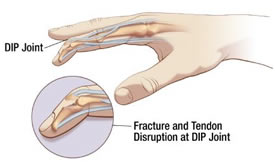Mallet Finger
Symptoms
 Mallet
finger is where the tip of the finger 'drops down' and cannot be straightened. This usually follows a relatively
minor injury, for example stubbing the finger.
Mallet
finger is where the tip of the finger 'drops down' and cannot be straightened. This usually follows a relatively
minor injury, for example stubbing the finger.
The reason that the finger cannot be straightened is that the tendon is pulled off of where it attaches to the end bone of the finger (distal phalanx). In some cases a piece of bone is pulled off with the tendon, this is called an avulsion fracture.
This problem should be treated; if ignored, the tip of the finger will catch on things and the first joint in the finger may compensate by bending backwards.
Diagnosis
The diagnosis is made from the history of the problem and examining the finger. An X-ray is performed to demonstrate whether or not there is an associated avulsion fracture.
Treatment
This problem is usually treated without surgery, using a custom made splint that holds the tip of the finger in a straight position while the tendon or bone heals. Tendons heal slowly, and it is necessary to splint the finger for 8 weeks. At the end of the period of splintage, my hand therapist will help with a simple exercise programme to restore the movement of the finger tip, as it becomes rather stiff with the splintage. The splint is checked weekly by my hand therapist and changed when necessary.
Surgery
It is not possible to repair the tendon or reattach it to the bone, as it is a very delicate structure (most other tendons in the hand can be repaired). In cases where there is an avulsion fracture and the piece of bone is quite large, surgery may be advised to reattach the bone fragment using a small screw or stiff wire (K-wire). Surgery may also be considered for patients who would be unable to work or would have significant difficulty if they had a splint on the finger; this includes patients who need to wash their hands frequently for example nurses or chefs and mothers with babies. The alternative treatment to a splint is a small operation where a fine stiff wire is passed across the finger joint to hold it in a straight position while the injury heals. The wire is buried under the skin at the tip of the finger, and removed at the end of the treatment. Insertion of the wire is a quick, minor operation performed under local anaesthetic.


